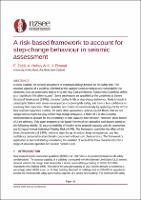| dc.description.abstract | In New Zealand, the seismic assessment of existing buildings focuses on life safety risk. The assessed capacity of a building is limited by the capacity corresponding to any vulnerability (or weakness) that can potentially lead to what the New Zealand Seismic Assessment Guidelines define as a “significant life safety hazard”. Some weaknesses are specified by the guidelines as Severe Structural Weaknesses (SSWs), characterized by brittle or step-change behaviour, likely to result in catastrophic failure with severe consequences concerning life safety, and there is less confidence in assessing their capacities. Their capacities are considered conservatively by applying a factor of 2 to their assessed capacities. Further, for some other weaknesses, such as precast floors, that are not categorised as SSWs but may exhibit step-change behaviour, a factor of 2 is also currently recommended to account for the uncertainty in their capacity determination. However, these factors of 2 are arbitrary. This paper proposes a risk-based framework to rationalize such factors based on the following criteria: (1) equal probability of fatality at the probable capacity used for assessment and (2) equal Annual Individual Fatality Risk (AIFR). The framework quantifies the effect of the three characteristics of SSWs: brittle or step-change behaviour, large consequences, and less confidence compared to a benchmark component without such characteristics. The framework’s application is demonstrated by considering the variation of each of the three characteristics for a range of assessed capacities and seismic hazard curves. | |

